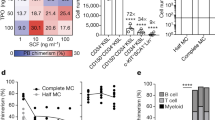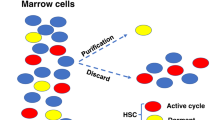Abstract
MANY techniques of cell culture involve suspension of cells in some fluid medium, and incubation in sterile glass containers, with subsequent counting of the suspended cells. Although it has long been known that certain cells are very ‘sticky' and can adhere most firmly to glass surfaces1, this fact seems to have been neglected in work with cell cultures, where some cells might be lost by irreversible adhesion to the walls of the culture vessel. The following is an attempt to investigate this point in bone-marrow culture ; here adhesion is of particular importance because only certain types of haemopoietic cells are ‘sticky'.
This is a preview of subscription content, access via your institution
Access options
Subscribe to this journal
Receive 51 print issues and online access
$199.00 per year
only $3.90 per issue
Buy this article
- Purchase on Springer Link
- Instant access to full article PDF
Prices may be subject to local taxes which are calculated during checkout
Similar content being viewed by others
References
Sherrington, C., Proc. Roy. Soc., 55, 161 (1894).
St. Rusznyak, Löwinger, S., and Lajtha, L., Nature, 160, 757 (1947).
Jaques, L. B., Fidlar, E., Feldsted, E. T., and Macdonald, A. G., Canad. Med. Assoc. J., 55, 26 (1946).
Barikine, W., Z. Immunitätsforsch., 8, 72 (1910).
Author information
Authors and Affiliations
Rights and permissions
About this article
Cite this article
CAIRNS, H., LAJTHA, L. Loss of White Cells in Bone Marrow Culture. Nature 162, 536–537 (1948). https://doi.org/10.1038/162536a0
Issue Date:
DOI: https://doi.org/10.1038/162536a0
Comments
By submitting a comment you agree to abide by our Terms and Community Guidelines. If you find something abusive or that does not comply with our terms or guidelines please flag it as inappropriate.



